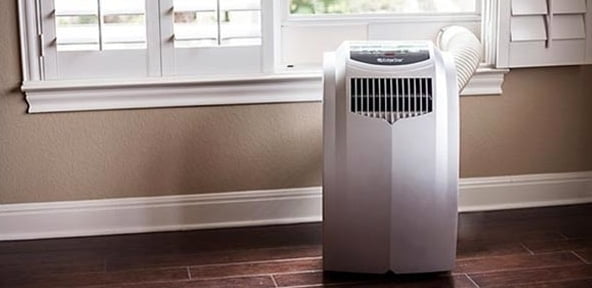Last Updated on April 1, 2023
High humidity is a problem. It makes the environment uncomfortable and reduces the efficiency of working. More importantly, high humidity levels lead to a damp and moldy environment that is bad for health. You might be wondering if you can extract humidity using your air conditioner. Can you use your portable AC as a dehumidifier?
Your portable AC also performs dehumidification with cooling. However, it is not as effective in doing so as a dehumidifier because dehumidification is their secondary function. Modern portable AC units have a ‘Dry mode’ for this purpose. In this mode, fan speed and compressor running time are continuously optimized to maximize removal of moisture.
What if your portable AC does not have a dehumidifier mode? Can it dehumidify the environment without cooling?
Well, it depends on the type of unit you have.
If your model has the Self-evaporating feature (like in most newer models), you will have to vent it, which means cooling too. But otherwise, you may use it as a dehumidifier, without venting. Don’t worry if you don’t get it, I plan to discuss this query in much more detail for you in this article.

During hot and humid weather in summer you may be using a portable AC for cooling your room. Good news is besides cooling your portable AC automatically also performs dehumidification.
However, this dehumidification of water vapors from atmosphere is a secondary function of your AC. Which means that dehumidification with your portable AC will not be as efficient as with a dedicated dehumidifier.
1. Dehumidify During Cooling by Your Portable AC
When you turn your portable AC ON, refrigeration starts, and evaporator coils start cooling.
When the coils are sufficiently cool, and temperature drops below what is called dew point, water vapors in the humid air convert to liquid state. This liquid extracted by dehumidification is called condensate.
In simple words, AC cooling coils are at a temperature lower than what is required for dehumidification. This is why, just by using your portable AC for cooling, you automatically regulate humidity in your living space on the side.
Note: Removal of water (condensate) from portable AC may be partially or completely autonomous.
If you have a portable AC with self-evaporative technology, water in the condensate pan will automatically be removed, either partially, or completely.
This is based on two types of portable ACs: Partially Evaporative and Fully Evaporative.
2. Use Dry (Dehumidification) Mode in Your Portable AC
Some portable ACs are provided with ‘Dry Mode‘. When you are using Dry or Dehumidification mode, the principle for removing humidity is the same as used for cooling.
However, in Dry Mode, your AC is much more efficient in removing humidity than in cooling mode. This is because your portable AC fan speed and compressor operation are continuously regulated to make dehumidification its priority.
Let me share a little more detail about what happens when you use ‘Dry Mode’ in your portable AC
In dry mode, the blower fan runs at a low speed and the compressor’s operating time is constantly adjusted according to the relative humidity detected by the sensor. This improves dehumidification and saves energy.
By the way, there is a reason for your AC fan running at a very low speed in dehumidifier mode. Actually, this causes cooling coils to become super cool and extract maximum humidity from the environment.
Some Cool Facts About Dehumidification by Portable AC
- The amount of humidity removed by your portable AC depends on the temperature below the dew point (the point below which dehumidification occurs).
- If temperature of cooling coils is higher than a specific value, the air will never reach saturation temperature and dehumidification will not occur.
- A portable AC unit larger compared to the size of the room will be less effective in removing humidity.
- That is why it is highly recommended that you buy a portable AC that is of accurate size and according to the measurement of the room (especially not larger when you need dehumidification).
3. Dehumidify Without Cooling and Dry Mode
As I said earlier, the primary function of a portable AC is to reduce the temperature of your room. They are just naturally able to dehumidify on the side. Thereby, using your portable AC for regulating humidity only is an inefficient way of doing so.
Secondly, using a portable AC for dehumidification will also cause a drop in your room’s temperature, especially if it doesn’t have a Dehumidification Mode.
But how to use your portable AC on rainy winter days, if it doesn’t have ‘Dry Mode’, and you only need dehumidification without cooling?
Well, there is a solution to do that if you don’t have a Dry Mode in your portable AC.

One way to do that is to minimize fan speed and vent hot air from your AC in the same room.
Doing this will allow the air to dehumidify, cool, and be delivered in the same room after it passes through the cooling coils of your portable AC. However, this cool air will be balanced by the warm air from the exhaust vent hose.
Theoretically, the cooling effect will be completely balanced by the heating effect of hot air from condenser coils. However, in actuality, the room will warm a little bit due to inefficiencies involved in working of your portable AC.
Note: Beware of using this strategy if you have a portable AC with self-evaporative technology i.e., partially or fully evaporative portable AC. This is because these units allow humidity to be rejected from the exhaust vent hose.
Most self-evaporative portable ACs are partially evaporative. This means most of the humidity will be sprayed back into the same room you exhaust it. This will result in a net effect of zero and a lot of waste of energy.
Even if you have an AC that is not self-evaporative, if high humidity is a problem every other day, I recommend not using this strategy in the long run. Mainly because it is inefficient and will cause a waste of electricity.
Portable AC Vs Dehumidifier: Does AC Come Any Close?
Portable AC and dehumidifier extract humidity using the same principle i.e., cooling below the dew point to condense water vapors. The working though is somewhat different.
How Dehumidifier Works Differently?
In portable AC, heat is rejected by passing a stream of air over the condenser coils. This hot air is delivered outdoors via an exhaust hose. While cool air is delivered indoors after passing through the evaporator coils.
This is not the case with dehumidifiers. You do not need to vent them.
Air is cooled after passing through evaporator coils. Humidity is extracted during this cooling. The cooled air is then passed through the hot coils that restore its temperature. This way dehumidification process is carried on without any change in room temperature.
How Efficient is a Dehumidifier in Comparison to Portable AC?
Dedicated dehumidifier units use the same principle for removing humidity as portable AC units. Except that they do it much more efficiently, effectively, and powerfully.
Dehumidifier consumes 1/10th of energy during its operation compared to a traditional air conditioner.
Moreover, the initial cost of a dehumidifier is lower compared to an air conditioner.
We must compare apples with apples, not oranges.
But what is the difference in performance and effectiveness in dehumidification, between a portable AC and a dehumidifier unit having the same price?
First of all, sizing of a Portable AC is different compared to other air conditioners.
Normally, AC units are sized for the room according to ASHRAE standards. But due to inefficiencies in Portable ACs, DOE uses new techniques to realize their cooling capacity. A reduced value indicates the true effectiveness of the unit for the size of the room.
So a Portable AC may have a listed value of 14000 Btu. However, according to DOE standards, its rating would be about 7500 Btu. This means it would be able to cover a room of up to 350 square feet.
Compare that to a dehumidifier, costing about 1/3 the price of that portable AC, that can cover an area of 4500 sq ft. This is a huge amount of difference in the price and capability. At one-third of the price, area coverage by the dehumidifier is 1000 sq ft more compared to that of the portable AC.
Limitation of This Analysis: For portable AC under consideration, cooling is considered a part of the operation with dehumidification.
What to Choose?
Dehumidifiers are more effective and efficient in dehumidification compared to portable ACs. They have lower initial cost too. But portable ACs allow cooling and dehumidification at the same time.
So if you live in an area where it is hot and humid, portable AC is a good idea, in case you don’t have a more efficient option. But if the goal is removing humidity only and temperature is not a concern, go with a dehumidifier.


